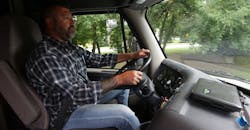Brent Nussbaum has advice for fleets that think they are guaranteed to reach higher fuel economy by simply throwing money at aerodynamic devices and maintaining the equipment.
“You can’t just expect the truck to do it for the driver,” said Nussbaum, CEO of Nussbaum Transportation. “The driver needs to have buy-in and understand the training.”
Mike Roeth, executive director of the North American Council for Freight Efficiency, shares a similar belief.
“Drivers will impact miles per gallon, no matter how much technology is on the truck,” Roeth said.
In fact, the difference in performance between the most and least efficient drivers could be as high as 35%, according to the Technology & Maintenance Council of American Trucking Associations.
Maintaining a steady pace of travel and leaving a sizable following distance minimizes the need for hard and fast acceleration and braking, which could result in up to a 20% difference in miles per gallon.
Higher speeds also translate into lower mpg. The American Transportation Research Institute (ATRI) found that when compared with traveling at 75 mph, driving at 55 mph saved 28% more fuel and driving at 65 mph saved 15%. ATRI noted while lower speeds increase transit time, maintaining a 65 mph pace increases travel times just 15.5%, compared with 75 mph.
Drivers who limit idling when stopped are also more likely to have a higher mpg average. Heavy-duty truck engines use up to one gallon of diesel per hour while idling. At 70% idle, the overall fuel economy is reduced by almost about one full mpg.
Using a battery-electric auxiliary power unit is one way to be more fuel efficient while making sure drivers have access to air conditioning or heating when needed.
Drivers also need to be alert enough to spot worn or under-inflated tires, clogged filters, and dirt buildup that could hurt fuel efficiency and lead to unplanned downtime. Even efforts to consolidate stops for food, fuel, showers, maintenance, and personal needs further maximize every gallon.
This is the first part in a series on how drivers can affect your fleet's bottom line. Check back tomorrow for Part 2.
About the Author
Neil Abt
Neil Abt is a former FleetOwner editor who wrote for the publication from 2017 to 2020. He was editorial director from 2018 to 2020.
